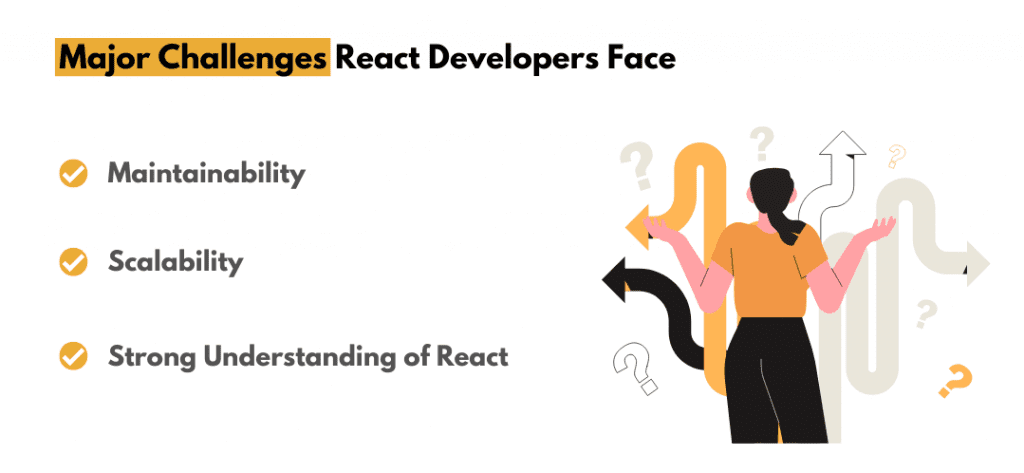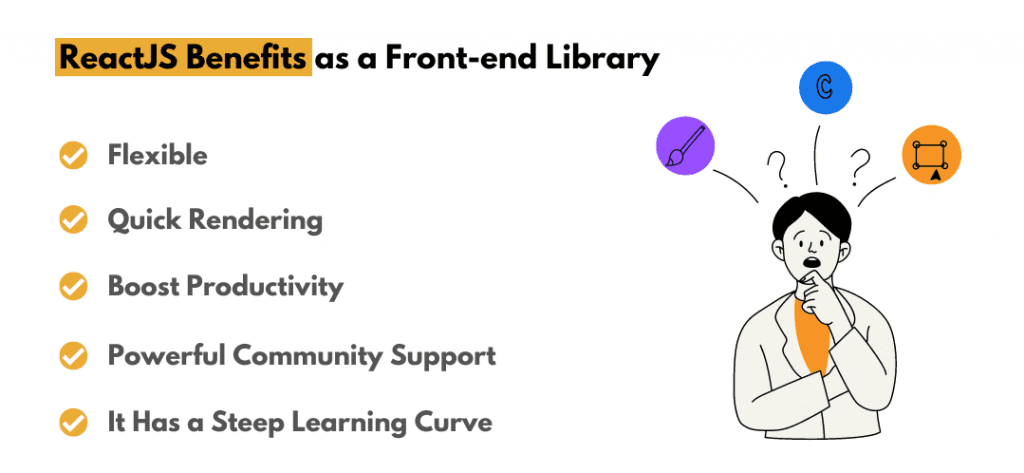Quick Summary: Stay ahead in the dynamic world of web development with these 20 React best practices. In 2023, React remains a powerful tool for building exceptional user interfaces. By following these expert tips, you'll optimize your codebase, improve performance, and ensure your React projects stand out in the ever-evolving digital landscape.
To ensure that your React projects are maintainable, efficient, and easy to understand, it is important to follow best practices when developing with React.
React is one of the most famous front-end frameworks for JavaScript. It is also one of the most-picked libraries for building web applications and creating excellent user interfaces.
As a ReactJS developer, it takes more than knowing how the library functions to create user-friendly, easily scalable, and maintainable applications. Understanding React conventions is equally important to create unique React code.
Even though ReactJS is simple to use and comprehend, project growth increases the complexity of the code. In this blog, we will discuss React best practices that will help React developers in development.
In The first part of this article, we'll discuss some of the typical problems that React developers run into, and in the second part, we'll focus on some of the React best practices you can use to write React code more quickly.
Let’s get started!
React Best Practices - Key Takeaways
- Use functional components whenever possible: Functional components are lightweight and perform better than class components. They are also easier to read and understand, making your code more maintainable.
- Avoid unnecessary re-renders: Use the React.memo Higher Order Component (HOC) to memoize components that don't need to be re-rendered on every change. You can also use the useCallback Hook to memoize functions that are passed as props to child components.
- Use the Virtual DOM efficiently: The Virtual DOM is a key feature of React that helps optimize performance. Use keys to help React identify which elements have changed and need to be updated.
- Optimize your state management: Keep your state as minimal as possible and use stateless components when appropriate.
3 Major Challenges React Developers Face

As a popular JavaScript library for building user interfaces, React has become a go-to choice for many developers. However, despite its popularity and ease of use, React developers still face a number of challenges.
These challenges can range from managing the complexity of large-scale applications to staying up-to-date with the constantly evolving React ecosystem. In this section, we will explore some of the most common challenges that React developers face and provide tips and react best practices for overcoming them.
1. Maintainability
This and reusability go hand in hand. The reusable components are simple to maintain in the beginning when the program and the React components are incredibly light. However, when requirements increase, reusing components sometimes become extraordinarily complicated and less maintainable.
Some frequently run into components that have a large number of cases, each of which represents a distinct result. Class names are applied conditionally, the functional component makes extensive use of switch statements, and the JSX is saturated with conditional renderings (ternary operators and simple && operators). There are numerous potential prop and state values, each causing a different result.
Well, there is nothing wrong with those methods in and of themselves. However, we believe that everyone should become familiar with the signs that a component is beginning to be less maintainable and when the techniques are being overused.
2. Strong Understanding of React
Lack of a fundamental understanding of how React functions is another major factor in the issues that developers encounter.
Many people, enter intermediate or advanced topics too quickly and without a firm basis. However, React is not the only example of this. It affects programming generally.
Being a developer without having a firm grasp of React might be problematic. It is said that when developers want to employ various component lifecycles but they don't know how to do so, headaches are often.
Recommended Read: Top 10 ReactJS Development Companies in 2023
3. Scalability
This challenge goes hand in hand with maintainability. It applies to all applications and is not only exclusive to the React code.
We discovered that creating outstanding software involves more than just user experience, tidy coding conventions, or inventive architecture, for instance. A software's ability to scale up or down affects its quality as well.
There are a variety of factors that contribute to the scalability of the software. Therefore, we have React best practices in this blog.
When you orchestrate all the components and arrange your project structure with maintainability and scalability in mind, we believe your developers will be less likely to produce a jumble of source code that requires significant refactoring.
In the next section, we will explore some of the best practices for React development. These practices will cover a wide range of topics, including component design, state management, performance optimization, and testing. By following these best practices, developers can build more efficient and maintainable applications that are also easier to test and debug.
React Best Practices in 2023
Writing React code can be a little difficult if the developers do not adhere to its best practices. Here are 20 ultimate react best practices to follow in 2023 to keep your ducks in a row.
- Significant File Organization
- Small and Specific Functional Components
- Don’t Use Indexes as a Key Prop
- Pick Fragments Over Divisions
- Naming Conventions
- Initializing React Component State Without Class Constructor
- DRY Your React Code
- Eliminating Redundancy with JavaScript Destructuring
- Prefer Passing Objects
- Use React Developer Tools
- Conditional Rendering Practices
- Use Snippet Libraries
- CSS in JavaScript
- Lazy Loading Implementation
- Testing and Monitoring Code
- Use a Fast and Secure Hosting Provider
- Managing State in ReactJS Application
- Writing clean and readable code using JSX
- Implementing proper routing with React Router
- Handling errors and debugging in a ReactJS application
1. Significant File Organization
Files that serve similar functions and are designed to work with a certain feature, should be kept together. For instance, all the styling files and other files related to a single component should be in the same location.
With the help of this practice, the developers can easily find related items in a single location. Consequently, users won't have to search the entire project for a specific file. No matter how large the project becomes, the file will always be located where it should be.
Developers can also opt for a component-centric file structure. This entails putting all the documents about one component in a single folder. For example, one can create a folder called NavBar that contains the navigation bar component itself, the styled-components, and any other JavaSript and asset files.
It is simple to reuse, share, and debug a component when all of its files are contained in a single folder.
2. Small and Specific Functional Components
As we all know, React allows the development of huge components that are capable of performing various tasks. However, it is best to structure them so that each one performs a specific purpose by keeping components modest.
Using React, developers produce reusable UI components. Smaller components are simpler to read and comprehend in terms of their operation and are easy to update. As a result, the code's usability is also improved. Each component is typically short (between 100 and 200 lines), making it simple for other programmers to comprehend and adjust the code.
3. Don't Use Indexes as a Key Prop
React uses keys to identify items inside an array uniquely. With these keys, it can easily find out which item has been inserted, modified, or removed inside an array. When rendering arrays, you may frequently use the index as the key.
const Items = () => {
const arr = ["apple", "banana", "cat", "dog", "egg"];
return (
<>
{arr.map((elem, index) => {
<li key={index}>{elem}</li>;
})}
</>
);
};While occasionally effective, using the index as the key can lead to problems if the list of items changes as expected. Think about the list below:
<code>const arr = ["apple", "banana", "cat", "dog", "egg"];</code>
The first item in the list, "apple," currently has an index of zero, but if someone adds another item to the top of the list, the index of "apple" will change to 1, which will also modify how the array behaves.
The method uses a unique value for the index to ensure that the arraylist's identification is preserved.
4. Pick Fragments Over Divisions
The code returned by any React component should be wrapped in one singular tag. Normally, <div> or a React fragment is used but it is one of the best practices to opt for React fragments.
Every tag or <div> you use acquires memory. Hence, the more the number of <div>, the more memory is needed by your website, more power is required, and more time is taken to load the website. This eventually results in slow website speed and poor user experience.
5. Naming Conventions
Naming conventions aid in making code easier to read. This holds for variables, React hooks, component names, and more. There is no official naming scheme provided in the React documentation but there are 3 main naming conventions used -
- Instead of referring to a specific app feature, component names should reflect their function. They should also be capitalized in camelCase.
- Keys that require constituents ought to have unique, non-random identifiers. Utilizing more than just indices as keys are advised. A key allocation that combines two different object attributes is acceptable.
- In camelCase, methods should be named for their purpose and function rather than being application-specific. In general, components are written in PascalCase and must be titled according to their purpose rather than their function in the project.
6. Initializing React Component State Without Class Constructor
Developers can be seen utilizing a class function to initialize a component's state in React. While following this technique is not detrimental, it may lead to more duplicate code, which will ultimately reduce the app's performance.
An example of a component with and without a class constructor is given below -
Without Class:
class MyComponent1 extends React.Component {
constructor(props) {
super(props)
// Initialize component State
this.state = {
count: 0
}
}
...
}With Class:
import React from 'react'
class MyComponent1 extends React.Component {
// Initialize component State
state = {
count: 0
}
...
}7. DRY Your React Code
DRY stands for Don't Repeat Yourself. As you all may have guessed, here this means - do not repeat your code. It simply aims to avoid the occurrence of repeated code.
React best practices offer you to write accurate and concise code, hence making it feasible and simple. The question is - how would you come to know if you are going to consolidate duplicate code?
Well, you just have to look for similarities and if you find any, then it means you are duplicating a code.
8. Eliminating Redundancy with JavaScript Destructuring
Destructuring is a JavaScript feature that divides up various data chunks from an array or object and assigns them to newly formed variables that the programmers have made. Later on, these fresh variables can be applied to a React component and arguments may be sent between parent and child components as props.
For instance, in the code below, the parent component (App) sends the child component (Total) its state data as a prop. Values repeat themselves four times.
import React from "react";
export default class App extends React.Component {
state = { value1: 2, value2: 5, value3: 6, value4: 8 };
render() {
return <Total values={this.state} />;
}
}function Total(props) {
return (
<h2>
sum:{" "}
{props.values.value1 +
props.values.value2 +
props.values.value3 +
props.values.value4}
</h2>
);
}
Using JavaScript restructuring to eliminate redundancy -
const {value 1, value 2, value 3, value 4} = props.values;Function Total(props){
const {value 1, value 2, value 3, value 4} = props.values;
Return <h2> Total: { value 1 + value 2 + value 3 + value 4 } </h2>;
}
9. Prefer Passing Objects
Most people pass set of primitive values but to restrict the number of props being passed, you must prefer passing an object. For instance, you can combine the details of an employee rather than passing each one individually. This function will not be changed to account for future data the student acquires.
// Don't pass primitives<EmployeeAccount
name={user.name}
email={user.email}
id={user.id}
/>
// Pass objects
<EmployeeAccount user={user} />
10. Use React Developer Tools
React developer tools come in handy while developing a React app. It comprehends the state, children, props, and component hierarchy. It also helps in debugging the code. Developers may easily construct interactive UIs with the aid of React developer tools.
New features are regularly added to the React Developer tool.
11. Conditional Rendering Practices
React allows users to create distinct components that encapsulate the needed behavior. Then, depending on the state of your React app, you can render some of the components. This is conditional rendering.
Now, there are a lot of ways to perform conditional rendering. However, using short circuit operators are the most easy and simple to use.
// Short circuit operator
const Total= ({total}) => {
return <div>
{total && <h1>Total: {total}</h1>}
</div>
}
12. Use Snippet Libraries
When writing code, you should always make an effort to employ the best and most latest syntax. You may keep your syntax up to date by using code snippets. They also help in ensuring that your code is error and bug free. Therefore, one of the React best practices that you should adhere to for improved efficiency is employing snippet libraries code snippets like ES7 React, Redux, JS Snippets, etc.
13. CSS in JavaScript
It is very common for an active project to have all its CSS styles in a single SCSS file. Global prefix help in avoiding name crashes, however, this technique may not come in handy when the project starts growing.
There are a lot of libraries React offers to write tests of CSS in JS solutions and the most popular libraries are EmotionJS and Glamorous. Here's how you can use the EmotionJS library -
Step 1: Use NPM to install EmotionJS
<code>npm install --save @emotion/core</code>
Step 2: Import EmotionJS in your React app
<code>import { jsx } from '@emotion/core'</code>
Step 3: Set properties of an element
let Component = props => {
return ( <div
css=
{...props}
/> )
}14. Lazy Loading Implementation
In simple words, lazy loading is a design pattern. You can reduce the initial load time by allowing portions of your application to load only when necessary. For instance, you may initially load the parts and modules needed for user registration and login. The remaining functional or class components can then be loaded based on user navigation.
To grow your React app, lazy loading is a great tool. Your website's load time slows down if your codebase is large. This is due to the fact that every time a user logs in, the entire app must be loaded.
15. Testing and Monitoring Code
Write tests for the components you help eliminate the probability of errors. Testing guarantees that the parts behave as you would anticipate. Jest, one of the most popular test React components, offers a setting in which you may run your tests.
Running your React apps in your browser allows you to test them as you create them. Any discovered problem would typically be presented on the screen. This is comparable to creating WordPress sites with DevKinsta, a program that lets you create, edit, and launch WordPress sites locally.
16. Use a Fast and Secure Hosting Provider
You can use a variety of tools that make managing and scaling your website simple when you host your website. The files on your local computer can be safely saved on the server because of the server that hosts your website. The main advantage of having your website hosted is that other people can view the amazing things you've produced.
Many platforms, like Firebase, Vercel, Netlify, GitHub Pages, as well as premium providers like Azure, AWS, GoDaddy, Bluehost, and others, offer free hosting services to developers.
17. Managing State in ReactJS Application
The process of handling the data that React functional components require in order to render themselves is known as react state management. Usually, this information is kept in the component's state object. The component will re-render itself when the state object changes.
It has all the information. The presentation, which includes the HTML, CSS, and formatting, makes up the remaining half. The presenting portion of the app relies on state and state management. A React application will only re-render itself when the state changes.
Recommended Read: How to Make Progressive Web Apps with React.js
18. Writing clean and readable code using JSX
As a developer, one may want to write clean code structure that is easy to read and simple to comprehend. You can use JSX shorthand, move unrelated code to a single component, and develop separate files for one component. Developers can also group function components together in hooks.
19. Implementing proper routing with React Router
The method of routing involves sending users to various websites in response to their requests or actions. The major application for ReactJS Router is the creation of single page web applications. Multiple routes are defined in the application using React Router.
The React Router Package, a standard library system built on top of React, is used to implement routing in React applications. It gives the information that will be displayed on the web page to the synchronous URL in the browser. It is mostly used for creating one-page web apps and preserves the application's regular structure and functionality.
20. Handling errors and debugging in a ReactJS application
Error handling and logging are frequently ignored by front-end developers. Any code segment that throws an error must be handled correctly, though. In addition, there are many ways to handle and log failures in React depending on the circumstance. Here are some practices that can be used by developers for handling and debugging errors -
- Error boundaries for class components
- Try-Catch for catch beyond boundaries
- React Error Boundary library
ReactJS Benefits as a Front-end Library

If you ask us about the best-suited front-end technologies for software development, React is going to be the first one. Well, if you are not sure about using React in your next project, here are 5 convincing benefits of ReactJS as a front-end library.
1. It Has a Steep Learning Curve
React is flexible, efficient, and declarative. Since React's relative simplicity is not only dependent on its file organization and component model, it is simpler to read and run the code. Naturally, React.JS spares developers from having to keep track of too many things cognitively.
Generally speaking, it does have a more flexible component approach and a simpler component tree. React also tends to have a far smaller dependency list, which is another important advantage of react. React seeks to make developers' lives easier by drastically decreasing the corresponding lists.
2. Flexible
When we talk about the flexibility of React, we mean the library's inherent modularity. The defining project architecture allows front-end React code to be bundled into unique components, laying a strong foundation for the optimization of the entire development process.
React holds a consistent position on the scale of opinionatedness; the library neither forces nor steers you toward its method of operating. On the one hand, it specifies the process for developing reusable components. It also has the freedom to choose how to handle routing and testing, arrange dependencies, and more.
3. Quick Rendering
React transforms into a strong performance-oriented solution ideal for developing content-focused applications, thanks to improved support for server-side rendering. The main factor in faster rendering and higher performance of React apps is simply React's Virtual DOM.
Quick rendering results in reduced load times and quick real-time performance adjustments depending on user traffic. It is a well-known fact that visitors are more likely to utilize your service or buy your goods if your website's pages load quickly.
4. Boost Productivity
This benefit stems from React's compatibility with JavaScript, JSX, and TypeScript. One will receive higher safety and fewer defects while writing in one of these programming languages. They also enable the development of reusable components. This strategy, which permits reusing React code, significantly boosts the overall productivity of the developers.
React's DevTools enable a variety of tasks, including analyzing React component trees, keeping track of component hierarchy, and more. Additionally, by giving developers access to convenient built-in debugging tools, they can enhance the developer experience. Therefore, one may open React DevTools and check to see if all your React components are right instead of creating console logs, manually inserting dev print statements, or using specialist debugging tools.
5. Powerful Community Support
When learning new technology or working on a challenging project, software developers can rely on their sense of community as a strong foundation. This feeling will undoubtedly come to React devs. The React library previously entered a growth loop and now appears to want to stay there for as long as possible.
React.js currently has over 160k stars and is the fifth-highest-rated repository on GitHub, with over 5 million applications publicly utilizing it. A robust ecosystem exists for React that one can use or contribute to. Additionally, navigating all of this information won't be too difficult because the React documentation is readily available on the official website.
Wrapping Up
Building React applications at scale typically appear to be a difficult undertaking that necessitates thinking about what is best for web developers.
The greatest advice is to experiment with various tools and scaling strategies for React applications. You can then move forward with coding more easily.
As a top React JS development company, we have experience dealing with the newest front-end technology advancements. If you have any suggestions for implementing your react project, feel free to reach out to us.













